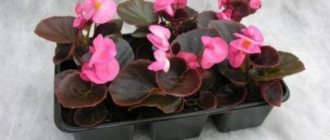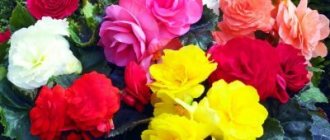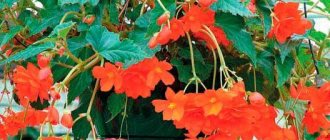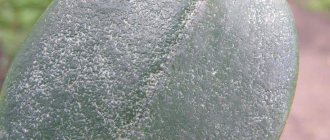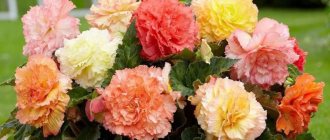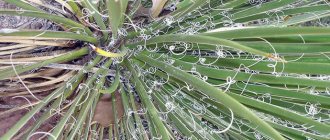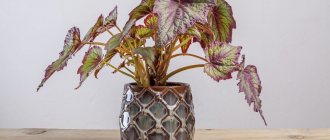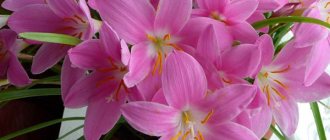Terry begonia is an amazing flower that can delight both indoor plant lovers and gardeners.
In the article we will talk about the features of terry begonia, its types, and most importantly, how to properly care for it at home.
This beautifully flowering shrub from the Begoniaceae genus has numerous carved leaves and large flowers reminiscent of small roses. The petals have a terry border at the tips, which explains the name of this flower.
Peculiarities
Terry begonia is especially common in the subtropical zone. Its homeland is considered to be Africa and India, from where it was actively imported to Europe in the 17th century to decorate the flower beds of noble people. Since then, various varieties of this flower have been selected, which can take root well in the climatic conditions of the temperate zone of Russia. The main feature of this plant is its appearance. Begonia buds are very reminiscent of rose flowers - just as multi-layered and delicate.
However, terry begonia, unlike most varieties of roses, is less picky in terms of care, so many flower garden owners prefer this particular flower for growing.
The plant is distinguished by a neat compact bush, as well as large buds, whose petals have a terry edge. The flowers themselves can have different shades depending on the variety. Traditional classic varieties, as a rule, have red, white or yellow bud colors, while newer ones offer gardeners to decorate their garden with pink or orange begonias. At the same time, the color of the petals may be uneven, which, in combination with the terry edge, makes the appearance of the bush even more interesting. The leaves of the plant themselves are large in size and have carved edges, which is an additional decorative highlight of the plant. Thus, the buds look more delicate and fragile against their background. Some begonia varieties have leaves that have a reddish tint or veins.
This flower is often actively used by designers to create beautiful flower arrangements and a festive mood at major celebrations.
As begonia grows, two unisexual flowers are formed - male and female. It is the male buds that have a terry edge and perform the main decorative function, while the female buds are necessary for further propagation of the plant - they contain a seed pod. Most varieties are planted in open ground at the end of spring, when the soil has already warmed up sufficiently. The plant blooms all summer, and some varieties of begonia, for example, ever-flowering ones, can delight the owner with their flowering until the onset of winter, and in regions with a warm climate - all winter. Begonia can be grown not only in open ground, but also at home.
Depending on the variety, terry begonia can differ in the structure of the root system into the following types:
- tuberous - more suitable for planting at home;
Plant characteristics
Tuberous begonia (Begonia tuberhybrida) is an unpretentious perennial plant. It looks great anywhere, is very versatile and extremely popular. Begonias were first described in history in 1690 by the French botanist Charles Plumiere. The name comes from another French plant expert, Michel Begon, and was used as a tribute. However, the delicate colorful flowers were known much earlier - according to historical sources, they were grown in China as early as the 14th century.
Numerous varieties make the begonia flower widespread and very popular among gardeners. The plant has been known in Europe for many years. Garden begonia flowers grow well in our climatic conditions; many varieties are created by crossing numerous species from Africa and the Andes.
Begonia is a small plant, the length of its shoots rarely exceeds 30 cm. The flower tends to branch quickly, which makes it even more attractive. It looks like a small bush decorated with beautiful flowers. The leaves are noteworthy - short, heart-shaped, fleshy and shiny, planted on rather long petioles.
Outdoor begonia blooms from June until the first frost, so it becomes the best decoration for the summer and autumn garden. Winter or ever-blooming begonia (Begonia x semperflorens-cultorum) is also known. Tuberous begonia owes its name to the fact that it forms underground tubers with the help of which it reproduces. Plants planted in the garden look very impressive. These flowers are also suitable for growing in pots, outdoor containers, and on balconies.
Description of the species yellow begonia
Yellow begonia is known by many names: double yellow begonia, tuberous yellow begonia - only the most common of them and are based on the appearance and structure of the plant's root system. In general, yellow begonia is a semi-shrub plant up to 45-50 cm high with recumbent shoots. The leaves reach a length of up to 20 cm, a width of up to 15 cm. The diameter of the flowers is up to 4 cm, however, it seems to be much larger, since the flowers are collected in large inflorescences. The flowers are orange-yellow, which gives the species its name.
Begonia ampelous yellow (also known as yellow begonia Pendula) has earned great popularity, as it is grown not only indoors, but is also widely used to create colorful flower arrangements, design flower beds and flower beds. Very often it is used by florists to decorate special events, weddings, for example. Its leaves and flowers are almost the same size - 10-20 cm; Pendula blooms from May to October.
Diseases and pests
Every gardener may encounter such an unpleasant phenomenon as terry begonia diseases.
Powdery mildew
The most common disease of begoniaceae is powdery mildew, which can be caused by sudden changes in temperature, drafts, or high humidity. Most often, outdoor plants experience this disease. A white coating appears on the leaves of the crop. If the flower is not cured in time, it will die.
To help a sick plant, you need to cut off all the affected parts. Treat the flower itself with fungicidal preparations.
The photo shows lesions on begonia leaves
Gray rot
Another common disease is root or gray rot. The disease manifests itself in the fact that a gray coating (mold) appears on the stem and leaves. Gray rot appears if the crop is in a cool room with high humidity.
You can get rid of gray rot in the following way: cut off all moldy parts of the flower, treat the remaining plant with special fungicidal agents.
Caring for yellow begonia
Caring for begonia, which is grown at home, is not at all burdensome and does not require special skills. It is only important to create partial shade for it, protect it from direct sunlight and ensure the air temperature is within 15-17 C.
Regarding watering, it should be moderate; begonia does not tolerate stagnation of water and this leads to rotting of the root system. The same result can be expected if there is not enough water, so you need to regularly check the condition of the soil and water it as it dries out. Often, but little by little.
Being a lover of moist air, but afraid of water droplets getting on the leaves, begonia will feel great on a tray with wet pebbles or expanded clay.
Given the growth rate, annual replanting is mandatory for begonias. The soil should be nutritious and, if possible, acidic. When replanting, the procedure of pruning the plant is also carried out - pruning.
Growing in pots
Potted begonias sometimes resemble tiny roses, which is why they are very popular. Caring for potted varieties is very similar to growing garden varieties.
- Landing place. The main thing is to provide shading; the flower grows well on northern windowsills without sun. Similar requirements apply to the beautiful royal begonia, which is found more often in homes than other species. The tuberous variety can be grown indoors all year round - it does not need a wintering period. The plant looks great in the back of the room - on shelves, on a table.
- Watering . The plant needs fairly regular irrigation - it cannot be filled with water in a pot, but it does not like even temporary drying out of the soil.
- Feeding . If you want to get thick, beautiful flowers, you need to take care of regular fertilization throughout the season - from February, March to late autumn. This is very important because begonias in pots have a very high demand for minerals. Properly selected fertilizers will be the best way to maintain an adequate level of substrate acidity. For this reason, it is worth using preparations specifically designed for fertilizing begonias.
Reproduction of yellow begonia
It is not difficult to propagate yellow begonia and methods of dividing the bush, using live bait, leaves, and sowing seeds are suitable for this. Cuttings cut from the stem are pressed into moist soil and rooted directly in the pots.
Seeds are sown between December and March, and disappear in the next 10-15 days. When the seedlings grow a little, they are packed into pots, and in the middle of summer they already bloom profusely.
If tubers are used for propagation, then it is advisable to plant them between February and June. The tubers are half-filled with moist soil, and the tray is placed in a dark, cool place. When the shoots sprout, the tray is moved to a warm place with enough light, and the tubers are completely covered with earth.
Top dressing
Begonia responds gratefully to treats in the form of fertilizing, and in flowering species this very flowering improves.
How and when to feed begonia:
- Only a month after planting or transplanting;
- Only outside the flowering and dormant periods;
- Only in the indicated doses: oversaturation kills the plant.
The easiest way is to go to a specialized store and ask for fertilizers for your begonia variety (for example, for deciduous varieties, those that will slow down the development of buds are good and vice versa). There is always a dosage on the package that must be followed, remembering the rule: it is better to underfill than overfill. Most often, fertilizers are applied once a week.
If you choose to add minerals yourself, these should be:
- Potassium and phosphorus for flowering begonia varieties;
- Nitrogen - for deciduous trees.
First meeting
Terry begonia belongs to the extensive genus Begoniaceae, which is native to the hot subtropics of Africa, South America and India. Plants of this genus were domesticated back in the 17th century; since then, the species and varietal diversity of begonias has exceeded tens and thousands.
Terry begonia is a compact, neat bush with beautiful carved leaves of reddish or green color and large flowers of bright colors - white, red, pink. yellow, orange. This type of begonia received its special beauty and its name thanks to the terry border on the flower petals.
Depending on the root system, tuberous and bush terry begonias are distinguished, and based on the height and growth pattern of the bush, they can be divided into ampelous and ordinary bushes. Almost all types of begonias produce two types of flowers - male and female. The former are highly decorative, while the latter are simple, non-double and small, but it is in their place that a seed pod will form over time.
The flowering period of these plants usually lasts throughout the summer, although some varieties, such as double everflowering begonia, may continue to bloom into autumn and even winter.
You can grow terry varieties of begonias both indoors and on the balcony, veranda or in the garden. The main thing is to choose the most comfortable place for them that meets all the requirements of agricultural technology.
Popular varieties
Begonia flower - propagation at home
Terry begonia varieties are divided into two large groups:
- bush begonia. Used for decorative purposes, when landscaping open areas;
- Tuberous begonia is the best option for indoor floriculture.
In domestic ornamental gardening, it is customary to distinguish the following varieties of begonias:
- foliage and decorative;
- decorative flowering.
Decorative deciduous varieties are characterized by unusually brightly colored foliage. The flowers are almost invisible against the background of enchanting leaves. Such begonias are used for landscaping and creating the structure of the garden.
The largest number of terry begonias among the last three varieties. Below are more details about some of them.
Begonia fragrant
The flowers of this series are characterized by a pleasant subtle aroma and ruffled lush flowers. There are several color options:
Red Glory - the bright red flowers of this variety are always visible from afar.
Red Glory
Sunrise with orange aroma and color. They attract butterflies and bees, enlivening the garden space.
Sunrise
White Angelica is a white double begonia. The flowers look like white and pink foam.
White Angelica
Begonia fringed
The flowers are similar in terry edges to large lush carnations. There are many varieties: salmon, orange, red fringed.
Fringed species
Ampelous begonia
A popular group of varieties ideal for vertical gardening. A distinctive feature is the long hanging stems. Notable flowers range from simple to double, with various color variations.
Ampel variety
Fiona
Delicate transparent pink flowers with double petals. Looks great in the garden. The buds are not prone to fading. There is a variety with light orange flowers. It has dark green large leaves. There are annual and ever-flowering subspecies.
Variety Fiona
Quinn
Perennial begonia. The best option for large flowerpots and rooms. The variety has half-open flowers of red, white, pink, and orange.
Queen variety
Yellow
Designed to create accents. It looks as if the sun has fallen into the garden. Large double flowers of bright yellow color and dark green medium-sized leaves are pleasing to the eye. Grow in spacious pots.
Variety Yellow
Fire coral
An annual variety with heavily double flowers. Buds with transitions of orange-coral-scarlet color. The effect of a fiery flower is created.
Variety Fire Coral
Rules for caring for begonias
Begonias are not too capricious, although they have such a reputation. If you provide them with suitable conditions from the very beginning, the plant will respond with abundant flowering and a minimum of requirements.
It is best to grow terry begonias in clay pots with drainage holes at the bottom. Clay is a porous material that will provide sufficient access of fresh air to the roots of the plant.
Recommendation! New clay pots should be soaked in water for several hours or a whole day before first use.
Begonias will require loose, nutritious soil with a slightly acidic reaction (pH 5.5-6.5). You can create a suitable mixture yourself. To do this, just mix:
- 2 parts leaf soil;
- 1 part river sand;
- 1 part humus;
- 1 part peat.
Watering mode, spraying
Begonia is a moisture-loving crop; it needs to be watered regularly and abundantly. The amount of irrigation depends on weather conditions. So, in spring and autumn it is enough to moisten the soil every 5-7 days. In hot weather, watering should be done every 3-4 days. It is important that the soil in the flowerbed is always slightly moist, but not wet.
Irrigation should be carried out early in the morning or after sunset. Otherwise, the moisture will overheat greatly, which will damage the roots and stems of the crop. Water for irrigation must be infused for 24 hours in advance and slightly heated. To do this, just pour it into a spacious container and leave it in the sun for 24 hours.
Begonia prefers high air humidity. But it does not tolerate the sprinkling procedure well, especially during flowering.
Begonia propagation
Depending on the type of terry begonia, it can be propagated in several ways:
- cuttings;
- seeds;
- sections of tubers.
The last method, as it is not difficult to understand, is available only for those terry begonias that belong to the tuberous family.
Reproduction by cuttings
This method is considered the simplest and most common; it is suitable for all types of begonias. The best time to take cuttings is early spring. Using a sharp knife, cut cuttings up to 10 cm long from the plant, remove the lower leaves and place them either in a container with water or directly in the soil.
Beauty for home and garden: variety of begonias, growing tips
Begonia (lat. Begonia) is a fairly easy to grow and care for ornamental plant that will give your home and garden bright and long-lasting, almost continuous flowering. The greatest variety of species and varieties creates ample opportunities to realize the creative imagination of the gardener. Ampel forms are perfect for hanging flowerpots.
Begonia is a very popular and well-proven indoor and garden plant. In open ground, begonias are grown as easily as primroses, geraniums or dahlias. The main nuances of growing begonias are simple:
- As a houseplant, they need a period of rest, with infrequent watering and storage at a slightly reduced temperature.
- In the garden, begonias can also be grown as an annual, which blooms so luxuriantly and is so inexpensive that it is not necessary to preserve its tubers in the winter. During the season, you can buy new varieties of begonias - selection does not stand still. Or you can take your favorite plant home from the garden for the winter.
Flowering begonias are famous for their lush multicolor, while decorative deciduous species are famous for their grace and variety of shapes and color shades of foliage. But the most luxurious flowers, of course, are the tuberous begonias. This plant is so popular in Europe that it is simply impossible to imagine a European garden, balcony, terrace or patio without begonias.
How to preserve tubers during the dormant period?
To avoid buying new begonias every year after summer flowering, you can try leaving their tubers. Gardeners practice this storage quite successfully. This happens after the plant begins to “fall asleep” and shed yellow leaves.
- For begonias over one year old:
During the cold period, the tubers should be stored in a cool place (you can use a refrigerator, cellar, country vestibule, etc.). The tubers are placed in an unclosed bag filled with peat, or in a box with sawdust, etc. Often the tubers are left directly in their original pots, put away in a secluded, cool place. Tubers do not need lighting.
- For first-year begonias:
Young begonias have not yet developed their stems to full strength, so there is no need to dig them up. We leave the babies in their pots at a temperature of about 15 degrees and water them once a week. It is important not to deprive begonias of good lighting so that they do not stretch into sad, thin and brittle sprouts. But there is no need to feed the plant alone: it still sleeps and does not develop.
